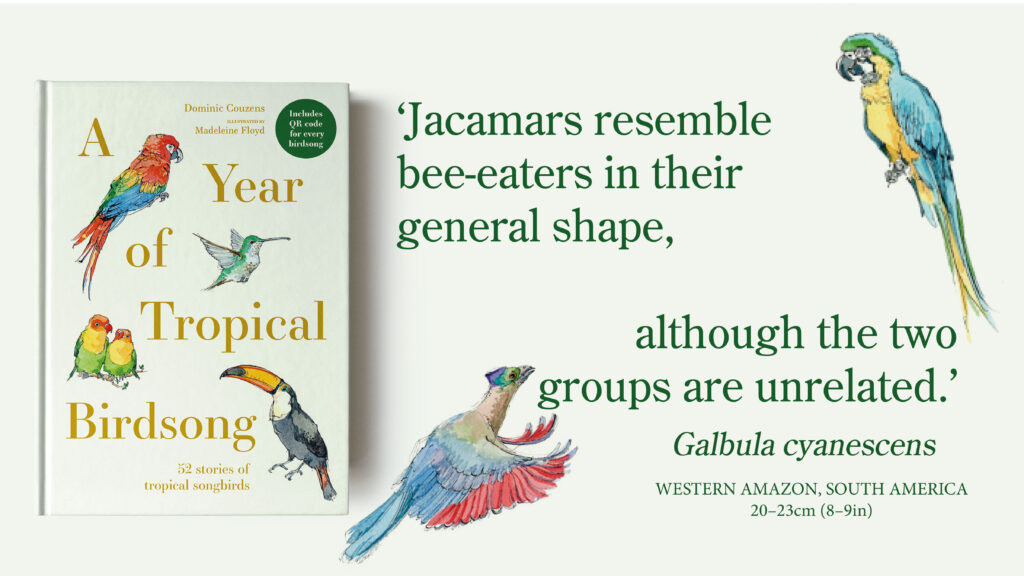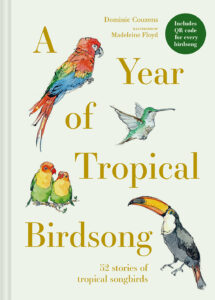Uncover the Bluish-fronted Jacamar

Fancy a flight into the world of tropical birds? Uncover the Bluish-fronted Jacamar with Dominic Couzens as he shares some secrets, taken from A Year of Tropical Birdsong.
By Dominic Couzens
HAVE YOU EVER WANDERED THROUGH a tropical forest glade and noticed a bloom of butterflies and wondered to yourself ‘I wonder what eats these?’
The answer, in South and Central America at least, is jacamars. These sharp-billed and sharp-eyed birds, small and dashing, are experts in catching insects in mid-air, and their diet encompasses copious butterfly flesh. They have favourite hunting perches, and after a while, a kaleidoscope of colourful wings will appear below these, as well as those of other prey such as dragonflies, bees, wasps and typical flies. Jacamars are found mainly on the edges of forests, by clearings where there is sufficient airspace, and they often hunt next to lakes and rivers.
They are, nonetheless, quite hard to spot. That’s because they spend a great deal of time watching and waiting for opportunities before striking. The typical view of a jacamar is of a slim, long-tailed bird perched still, its bill held up at an angle of 70 degrees or so, which presumably gives it the field of view it requires. Prey is invariably caught in mid-air which means that, somewhat curiously, any butterfly that wishes to evade capture has only to land and keep still and it will be safe.
Jacamars resemble bee-eaters in their general shape, although the two groups are unrelated.
Jacamars resemble bee-eaters (see page 72) in their general shape, although the two groups are unrelated, and bee-eaters spend much more time aloft. However, both groups have long, slender bills with sharp tips. Most birds that catch flying insects, such as swallows and flycatchers of all sorts, have very short bills and a wide gape. Jacamars and bee-eaters, however, do not, and there is some speculation as to why they are different. One possibility is that, because both groups take quite large prey with rapid wingbeats, a long bill keeps struggling invertebrates from damaging the hunter’s eyes and face when captured. It’s also true that the longer the bill, the faster the tips shut together.
In recent years, researchers have found that jacamars can be extremely selective in the prey that they catch. This is necessary because many insects of different types are distasteful, or even poisonous. This includes butterflies. It seems that young jacamars learn this the hard way, by snapping noxious insects and getting their taste buds burned. Over time, they begin to distinguish palatable butterflies from unpalatable species, by sight, often with great precision.
Not only do they recognize them in flight before catching them, but they also quickly let go of an insect that they have caught in error. In South America, there are a lot of butterflies fluttering about with tears in their wings.
What is particularly impressive about this is that many palatable butterfly species have evolved to resemble unpalatable ones (known as Müllerian mimicry), and there is good evidence that jacamars are sufficiently sharp-eyed to see through the deception. Furthermore, both the palatable species and their mimics show great regional variation, further confusing the picture. It is thought that, as the prime avian predators of butterflies in neotropical forests, jacamars drive the selection pressure that energizes the mimicry.
In order to catch insects effectively, jacamars need to be territorial so that they aren’t disturbed by competitors while hunting. As such, they are noisy, and their ringing calls are a familiar part of the forest-edge soundscape.
Experience the sounds of the Bluish-fronted Jacamar here.
More about A Year of Tropical Birdsong
From the incredible screech of the macaw, who shows amazing intelligence, to the imitations of humans of the mynah bird and the humming sounds of the hummingbird, this is a beautiful collection of stories about one of nature’s wonders: tropical birds. Bird expert and writer Dominic Couzens invites you to enjoy not only their songs but also their amazing feats and colourful displays.
With stunning illustrations from award-winning Madeleine Floyd and QR codes to listen to their songs as you read, you can immerse yourself in a tropical wonderland. Available to purchase here and from all good booksellers.


